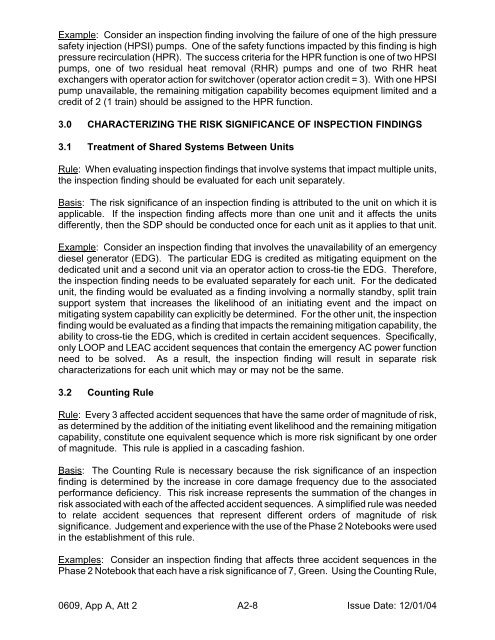IMC 0609, App A - NRC
IMC 0609, App A - NRC
IMC 0609, App A - NRC
You also want an ePaper? Increase the reach of your titles
YUMPU automatically turns print PDFs into web optimized ePapers that Google loves.
Example: Consider an inspection finding involving the failure of one of the high pressure<br />
safety injection (HPSI) pumps. One of the safety functions impacted by this finding is high<br />
pressure recirculation (HPR). The success criteria for the HPR function is one of two HPSI<br />
pumps, one of two residual heat removal (RHR) pumps and one of two RHR heat<br />
exchangers with operator action for switchover (operator action credit = 3). With one HPSI<br />
pump unavailable, the remaining mitigation capability becomes equipment limited and a<br />
credit of 2 (1 train) should be assigned to the HPR function.<br />
3.0 CHARACTERIZING THE RISK SIGNIFICANCE OF INSPECTION FINDINGS<br />
3.1 Treatment of Shared Systems Between Units<br />
Rule: When evaluating inspection findings that involve systems that impact multiple units,<br />
the inspection finding should be evaluated for each unit separately.<br />
Basis: The risk significance of an inspection finding is attributed to the unit on which it is<br />
applicable. If the inspection finding affects more than one unit and it affects the units<br />
differently, then the SDP should be conducted once for each unit as it applies to that unit.<br />
Example: Consider an inspection finding that involves the unavailability of an emergency<br />
diesel generator (EDG). The particular EDG is credited as mitigating equipment on the<br />
dedicated unit and a second unit via an operator action to cross-tie the EDG. Therefore,<br />
the inspection finding needs to be evaluated separately for each unit. For the dedicated<br />
unit, the finding would be evaluated as a finding involving a normally standby, split train<br />
support system that increases the likelihood of an initiating event and the impact on<br />
mitigating system capability can explicitly be determined. For the other unit, the inspection<br />
finding would be evaluated as a finding that impacts the remaining mitigation capability, the<br />
ability to cross-tie the EDG, which is credited in certain accident sequences. Specifically,<br />
only LOOP and LEAC accident sequences that contain the emergency AC power function<br />
need to be solved. As a result, the inspection finding will result in separate risk<br />
characterizations for each unit which may or may not be the same.<br />
3.2 Counting Rule<br />
Rule: Every 3 affected accident sequences that have the same order of magnitude of risk,<br />
as determined by the addition of the initiating event likelihood and the remaining mitigation<br />
capability, constitute one equivalent sequence which is more risk significant by one order<br />
of magnitude. This rule is applied in a cascading fashion.<br />
Basis: The Counting Rule is necessary because the risk significance of an inspection<br />
finding is determined by the increase in core damage frequency due to the associated<br />
performance deficiency. This risk increase represents the summation of the changes in<br />
risk associated with each of the affected accident sequences. A simplified rule was needed<br />
to relate accident sequences that represent different orders of magnitude of risk<br />
significance. Judgement and experience with the use of the Phase 2 Notebooks were used<br />
in the establishment of this rule.<br />
Examples: Consider an inspection finding that affects three accident sequences in the<br />
Phase 2 Notebook that each have a risk significance of 7, Green. Using the Counting Rule,<br />
<strong>0609</strong>, <strong>App</strong> A, Att 2 A2-8 Issue Date: 12/01/04
















